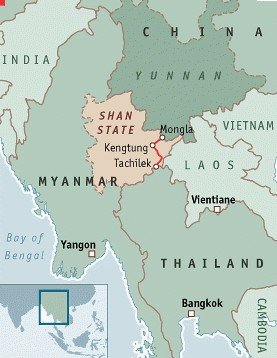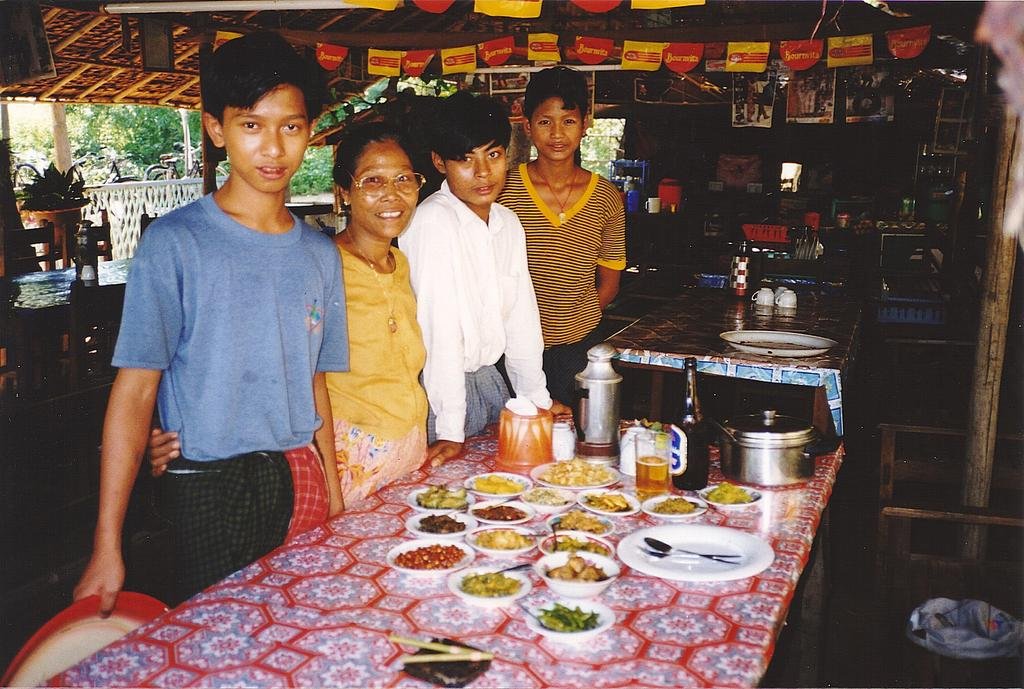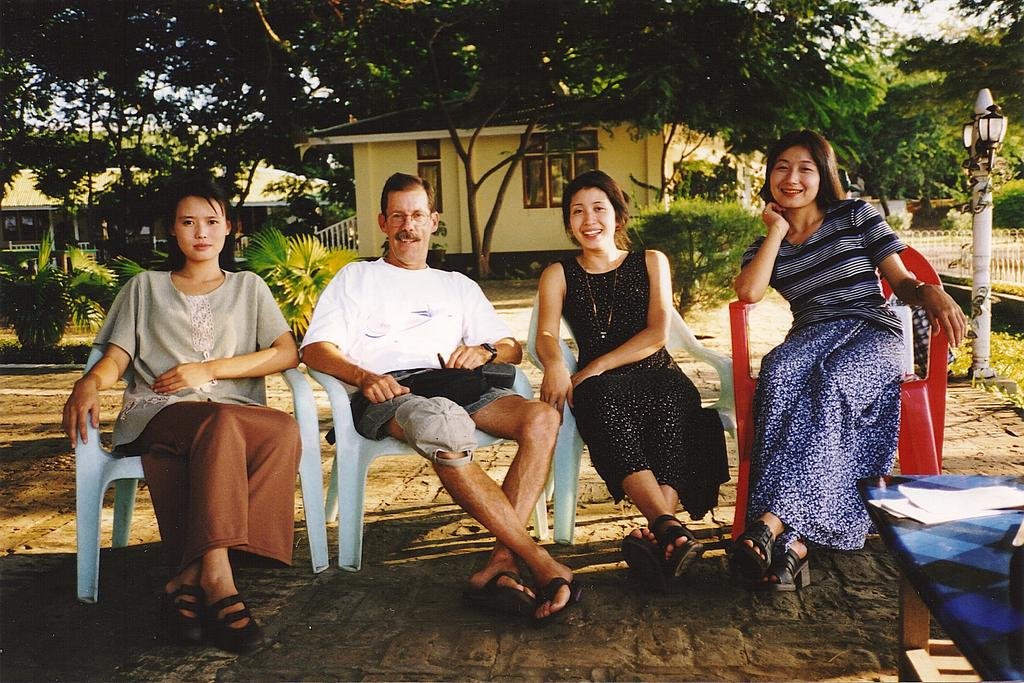KTMphil
Senior member
Brief History Of Shan State, Myanmar
After our visit last weekend to the Loi Tai Leng, Shan State, Myanmar, rebel army base, report below:
we-got-in-a-night-the-shan-st-myanmar-rebel-army-camp-t784.html
- Here is a brief recent history summary of Shan State from Kun Philip (Shan rebel army government official) & the rebel army's propaganda:

1815-1818, British occupied India and annexed Assam (where the majority of the Shan lived).
British troops pushed into Burma & in 1824, 1852 & 1885 the Burmese resisted British invasions.
In the meantime fighting had broken out in the Shan provinces over territory disputes.
2 Shan provinces requested British protection, after this, the British sent its troops into the whole of Shan state and the whole of Shan state became a protectorate of the British Empire in 1886.
In the meantime, France started to invade Vietnam, Laos & Cambodia. To prevent war between the 2 Empires, a demarcation border was set up without the consents of the local people, separating families and preventing the local people from moving freely.
During WW II, the British promised to grant independence to that colonies that supported them against the Japanese invasion, the Shan people helped the British, the war ended in August 1945 & the Shan state people prepared for their independence from Britain.
Shan state council was formed in 1947, & the Shan Sao Phas and its leaders decided to stay under the British Empire, as they felt they were not ready in terms of governing & political knowledge, but had stated that when they were ready they would be independent and Britain had promised to grant independence at that time, when they were ready.
Meanwhile, Gen. Aung San and the Burmese leaders, started to persuade the Shan leaders to join them in trying to gain independence from the British & in 1947 several of the Shan groups signed an agreement with Gen. Aung San & the Burmese to form a federal union of Burma to try and obtain independence from Britain.
The agreement was known as the "Panglong Agreement" & laid the foundation for Burma's constitution in 1948. The agreement guaranteed the Shan state secession from the union with Burma after 10 years (if they wished).

1950 Komingtang was defeated by the Chinese Communist government, led by Mao Tse-Tung & the Komingtang troops fled into Shan state.
Burmese army did not defend the border against the Chinese Komingtang & seized Shan state as they then regarded Shan state as the no. 1 threat to Burmese power.
1956 worsening human rights situation by the Burmese on the Shan people, prompted the "Shangha association" to be formed with the goal of fighting for rights in the region. On 7th Feb 1957 Shan state people rallied peacefully for their rights in the region.
16-19 May, 1957, Shan leaders hold a conference in Mong Yaiand & agree to form an army to protect Shan state as they believed that the Burmese government would not honor the 10 year the secession from the union with Burma agreement that had been signed in 1948.
21st May, 1958, 30 comrades with 7 guns form a Shan state resistance army, leader called Sao Noi.
News of this rebel group fighting with the Burmese army spreads throughout Shan state, being 10 years after the signed agreement for Shan state's freedom, battles for freedom spread like wildfire.
Shan patriots agree that Sao Noi should be the first Shan state leader & was commemorated that 21st May, 1958, would be "Shan state peoples resistance day", as this was the first day he & his comrades resisted the Burmese army.
From Wikipedia:
http://en.wikipedia.org/wiki/Shan_State
Independence (1948–2010)
Soon after gaining independence in January 1948, the central government led by U Nu faced several armed rebellions. The most serious was the Chinese Nationalist KMT invasion of Shan State in 1950. Driven out by the Chinese Communist forces, Nationalist KMT armies planned to use the region east of the Salween river as a base from which to regain their homeland. In March 1953, the KMT forces with US assistance were on the verge of taking the entire Shan State, and within a day's march of the state capital Taunggyi.[17] The Burmese army drove back the invaders east across the Salween but much of the KMT army and their progeny would remain in the eastern Shan State under various guises to the present day. The Burmese army's heavy handedness fueled resentment.[17]
In 1961, Shan saophas led by the first president of Burma and saopha of Yawnghwe Sao Shwe Thaik proposed a new federal system of government for greater autonomy even though the Shans had the constitutional right to secede. Though Shan leaders promised not to exercise the right, it was seen by the Burmese army led by Gen. Ne Win as secessionist.[17] Gen. Ne Win's coup d'etat in 1962 brought an end to the Burmese experiment with democracy and with it, the call for greater autonomy for ethnic minorities. The coup fueled the Shan rebellion, started in 1958 by a small group called Num Hsük Han (Young Warriors), now joined by the Shan State Army (SSA).
By the early 1960s, eastern Shan State, festered with several insurgencies and warlords, emerged as a major opium growing area, part of the so-called Golden Triangle. Narcotics trafficking became a vital source of revenue for all insurgencies. Major forces consisted of the SSA, Communist Party of Burma (CPB) as well as those of drug lords Khun Sa, and Lo Hsing Han. By the mid-1960s, CPB had begun receiving open support from China. Thailand also began a decades-long policy of support for non-Communist Burmese rebels. Families of insurgent leaders were allowed to live in Thailand, and insurgent armies were free to buy arms, ammunition, and other supplies.[18]
In the late 1980s and 1990s, the military government signed ceasefire agreements with 17 groups, including all major players in Shan State. An uneasy truce has ensued but all forces remain heavily armed. Today, the 20,000 strong United Wa State Army (UWSA) is the largest armed group, and heavily involved narcotics trade. In the 2008 Constitution, endorsed by the Burmese junta, certain UWSA controlled areas were given the status of an autonomous region.[19]
In recent decades, Chinese state and ethnic Chinese involvement in Shan State has deepened. Hundreds of thousands of illegal immigrants from China have come to work in Upper Burma since the 1990s.[20][21] Chinese investment in the state has funded everything from hydropower and mining projects to rubber plantations, illegal logging, and illegal wildlife trafficking.[22] Wa and Kokang regions, led by ethnic Chinese, openly use the yuan and operate on Chinese Standard Time.
After our visit last weekend to the Loi Tai Leng, Shan State, Myanmar, rebel army base, report below:
we-got-in-a-night-the-shan-st-myanmar-rebel-army-camp-t784.html
- Here is a brief recent history summary of Shan State from Kun Philip (Shan rebel army government official) & the rebel army's propaganda:

1815-1818, British occupied India and annexed Assam (where the majority of the Shan lived).
British troops pushed into Burma & in 1824, 1852 & 1885 the Burmese resisted British invasions.
In the meantime fighting had broken out in the Shan provinces over territory disputes.
2 Shan provinces requested British protection, after this, the British sent its troops into the whole of Shan state and the whole of Shan state became a protectorate of the British Empire in 1886.
In the meantime, France started to invade Vietnam, Laos & Cambodia. To prevent war between the 2 Empires, a demarcation border was set up without the consents of the local people, separating families and preventing the local people from moving freely.
During WW II, the British promised to grant independence to that colonies that supported them against the Japanese invasion, the Shan people helped the British, the war ended in August 1945 & the Shan state people prepared for their independence from Britain.
Shan state council was formed in 1947, & the Shan Sao Phas and its leaders decided to stay under the British Empire, as they felt they were not ready in terms of governing & political knowledge, but had stated that when they were ready they would be independent and Britain had promised to grant independence at that time, when they were ready.
Meanwhile, Gen. Aung San and the Burmese leaders, started to persuade the Shan leaders to join them in trying to gain independence from the British & in 1947 several of the Shan groups signed an agreement with Gen. Aung San & the Burmese to form a federal union of Burma to try and obtain independence from Britain.
The agreement was known as the "Panglong Agreement" & laid the foundation for Burma's constitution in 1948. The agreement guaranteed the Shan state secession from the union with Burma after 10 years (if they wished).

1950 Komingtang was defeated by the Chinese Communist government, led by Mao Tse-Tung & the Komingtang troops fled into Shan state.
Burmese army did not defend the border against the Chinese Komingtang & seized Shan state as they then regarded Shan state as the no. 1 threat to Burmese power.
1956 worsening human rights situation by the Burmese on the Shan people, prompted the "Shangha association" to be formed with the goal of fighting for rights in the region. On 7th Feb 1957 Shan state people rallied peacefully for their rights in the region.
16-19 May, 1957, Shan leaders hold a conference in Mong Yaiand & agree to form an army to protect Shan state as they believed that the Burmese government would not honor the 10 year the secession from the union with Burma agreement that had been signed in 1948.
21st May, 1958, 30 comrades with 7 guns form a Shan state resistance army, leader called Sao Noi.
News of this rebel group fighting with the Burmese army spreads throughout Shan state, being 10 years after the signed agreement for Shan state's freedom, battles for freedom spread like wildfire.
Shan patriots agree that Sao Noi should be the first Shan state leader & was commemorated that 21st May, 1958, would be "Shan state peoples resistance day", as this was the first day he & his comrades resisted the Burmese army.
From Wikipedia:
http://en.wikipedia.org/wiki/Shan_State
Independence (1948–2010)
Soon after gaining independence in January 1948, the central government led by U Nu faced several armed rebellions. The most serious was the Chinese Nationalist KMT invasion of Shan State in 1950. Driven out by the Chinese Communist forces, Nationalist KMT armies planned to use the region east of the Salween river as a base from which to regain their homeland. In March 1953, the KMT forces with US assistance were on the verge of taking the entire Shan State, and within a day's march of the state capital Taunggyi.[17] The Burmese army drove back the invaders east across the Salween but much of the KMT army and their progeny would remain in the eastern Shan State under various guises to the present day. The Burmese army's heavy handedness fueled resentment.[17]
In 1961, Shan saophas led by the first president of Burma and saopha of Yawnghwe Sao Shwe Thaik proposed a new federal system of government for greater autonomy even though the Shans had the constitutional right to secede. Though Shan leaders promised not to exercise the right, it was seen by the Burmese army led by Gen. Ne Win as secessionist.[17] Gen. Ne Win's coup d'etat in 1962 brought an end to the Burmese experiment with democracy and with it, the call for greater autonomy for ethnic minorities. The coup fueled the Shan rebellion, started in 1958 by a small group called Num Hsük Han (Young Warriors), now joined by the Shan State Army (SSA).
By the early 1960s, eastern Shan State, festered with several insurgencies and warlords, emerged as a major opium growing area, part of the so-called Golden Triangle. Narcotics trafficking became a vital source of revenue for all insurgencies. Major forces consisted of the SSA, Communist Party of Burma (CPB) as well as those of drug lords Khun Sa, and Lo Hsing Han. By the mid-1960s, CPB had begun receiving open support from China. Thailand also began a decades-long policy of support for non-Communist Burmese rebels. Families of insurgent leaders were allowed to live in Thailand, and insurgent armies were free to buy arms, ammunition, and other supplies.[18]
In the late 1980s and 1990s, the military government signed ceasefire agreements with 17 groups, including all major players in Shan State. An uneasy truce has ensued but all forces remain heavily armed. Today, the 20,000 strong United Wa State Army (UWSA) is the largest armed group, and heavily involved narcotics trade. In the 2008 Constitution, endorsed by the Burmese junta, certain UWSA controlled areas were given the status of an autonomous region.[19]
In recent decades, Chinese state and ethnic Chinese involvement in Shan State has deepened. Hundreds of thousands of illegal immigrants from China have come to work in Upper Burma since the 1990s.[20][21] Chinese investment in the state has funded everything from hydropower and mining projects to rubber plantations, illegal logging, and illegal wildlife trafficking.[22] Wa and Kokang regions, led by ethnic Chinese, openly use the yuan and operate on Chinese Standard Time.













